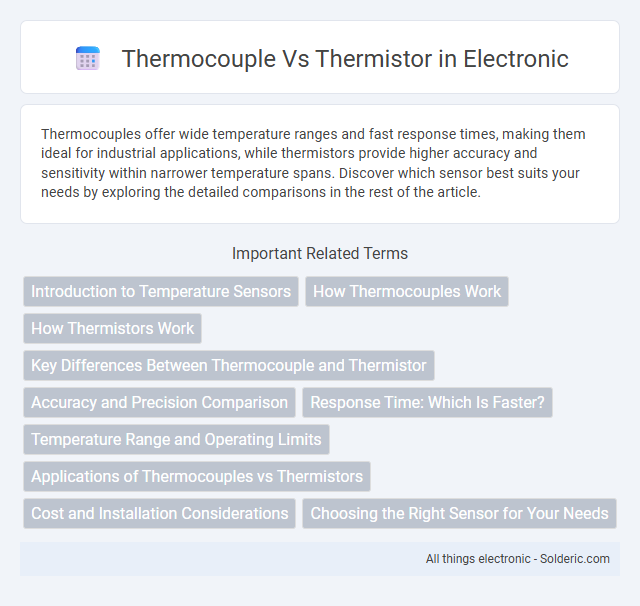Thermocouples offer wide temperature ranges and fast response times, making them ideal for industrial applications, while thermistors provide higher accuracy and sensitivity within narrower temperature spans. Discover which sensor best suits your needs by exploring the detailed comparisons in the rest of the article.
Comparison Table
| Feature | Thermocouple | Thermistor |
|---|---|---|
| Temperature Range | -200degC to 1750degC | -90degC to 130degC |
| Accuracy | +-1degC to +-5degC | +-0.1degC to +-1degC |
| Response Time | Fast (milliseconds) | Moderate (seconds) |
| Output Signal | Millivolt (Seebeck voltage) | Resistance change |
| Durability | High (withstands harsh environments) | Lower (sensitive to mechanical stress) |
| Cost | Low to moderate | Low |
| Application | Industrial processes, high temperatures | Medical devices, HVAC, precise low-temp measurements |
| Calibration | Requires frequent calibration | More stable, less frequent calibration |
Introduction to Temperature Sensors
Thermocouples and thermistors are essential temperature sensors used in various industrial and scientific applications. Thermocouples measure temperature by generating a voltage based on the junction of two different metals, offering a wide temperature range and fast response time. Thermistors, made of semiconductor materials, provide high accuracy and sensitivity within a narrower temperature range, making them ideal for precise temperature control in Your devices.
How Thermocouples Work
Thermocouples measure temperature by generating a voltage based on the Seebeck effect, which occurs when two dissimilar metal wires are joined at one end and exposed to varying temperatures. The voltage produced correlates directly to the temperature difference between the joined end and the reference junction, allowing precise temperature readings. Understanding how thermocouples work helps you select the appropriate sensor for applications requiring wide temperature ranges and fast response times.
How Thermistors Work
Thermistors operate based on the principle that their electrical resistance changes significantly with temperature variations, allowing precise temperature measurement. They are made from semiconductor materials that cause a predictable resistance change when exposed to heat, categorized as Negative Temperature Coefficient (NTC) or Positive Temperature Coefficient (PTC) types. This property enables thermistors to convert temperature changes into measurable electrical signals for applications in temperature sensing, control, and compensation.
Key Differences Between Thermocouple and Thermistor
Thermocouples measure temperature by generating a voltage based on the junction of two different metals, offering a wide temperature range from -200degC to 1750degC, while thermistors rely on resistance changes in semiconductor materials with a more limited range typically between -50degC to 150degC. Accuracy of thermistors is higher within their range, often within +-0.1degC, compared to thermocouples, which vary around +-1degC but excel in harsh environments due to their durability and faster response time. Your choice depends on the application's temperature range, required precision, and environmental conditions, with thermocouples preferred for extreme temperatures and thermistors for precise, stable readings at moderate temperatures.
Accuracy and Precision Comparison
Thermocouples offer wide temperature ranges but generally exhibit lower accuracy and precision compared to thermistors, which provide highly precise and stable readings within narrower temperature spans. Thermistors, especially Negative Temperature Coefficient (NTC) types, can achieve accuracies up to +-0.1degC and better repeatability, making them ideal for applications requiring fine temperature control. Thermocouples typically have accuracy around +-1degC to +-2degC, affected by cold junction compensation and signal noise, which limits their precision in sensitive measurements.
Response Time: Which Is Faster?
Thermocouples generally offer faster response times than thermistors due to their simpler construction and direct junction measurement, typically reacting within milliseconds. Thermistors, while highly sensitive and accurate for temperature changes, have slower response rates often ranging from hundreds of milliseconds to several seconds because of their larger thermal mass. Therefore, for applications requiring rapid temperature sensing, thermocouples are preferred over thermistors.
Temperature Range and Operating Limits
Thermocouples offer a wide temperature range typically from -200degC to 2500degC, making them suitable for extreme heat applications. Thermistors generally operate within a narrower range, approximately -55degC to 150degC, which limits their use to lower temperature environments. Your choice depends on the required temperature span, with thermocouples excelling in high-temperature conditions and thermistors providing high accuracy in moderate ranges.
Applications of Thermocouples vs Thermistors
Thermocouples are widely used in industrial applications requiring high temperature measurements, such as metal processing, gas turbines, and engine monitoring, due to their broad temperature range and durability. Thermistors, on the other hand, excel in precise temperature sensing for medical devices, consumer electronics, and HVAC systems because of their high sensitivity and accuracy within moderate temperature ranges. Choosing between thermocouples and thermistors depends on your specific application needs, including temperature range, response time, and environmental conditions.
Cost and Installation Considerations
Thermocouples generally offer lower initial costs and simpler installation due to their robust design and ability to withstand extreme temperatures, making them ideal for industrial applications. Thermistors, while more expensive and sensitive to environmental factors, provide higher accuracy and are typically easier to integrate into electronic control systems with minimal calibration. Understanding these cost and installation differences helps ensure you select the optimal sensor for your temperature measurement needs.
Choosing the Right Sensor for Your Needs
Thermocouples offer a wide temperature measurement range from -200degC to 1750degC, making them ideal for high-temperature applications, while thermistors provide higher accuracy and sensitivity within a narrower range, typically -55degC to 150degC. Your choice depends on factors like required temperature range, precision, response time, and environmental conditions. For rapid response and precise control in moderate temperatures, thermistors are preferable, whereas thermocouples excel in rugged, high-temperature environments.
thermocouple vs thermistor Infographic

 solderic.com
solderic.com